Title of the work
Country of the First Edition
Country/countries of popularity
Original Language
First Edition Date
First Edition Details
Renée Grimaud, Alphabêta. L’alphabet grec par ses légendes. Paris: Seuil, 1995, 63 pp.
ISBN
Available Onllne
Demo of 15% pages available at Gallica.bnf.fr (accessed: October 15, 2021)
Genre
Anthology of myths*
Myths
Target Audience
Children
Cover
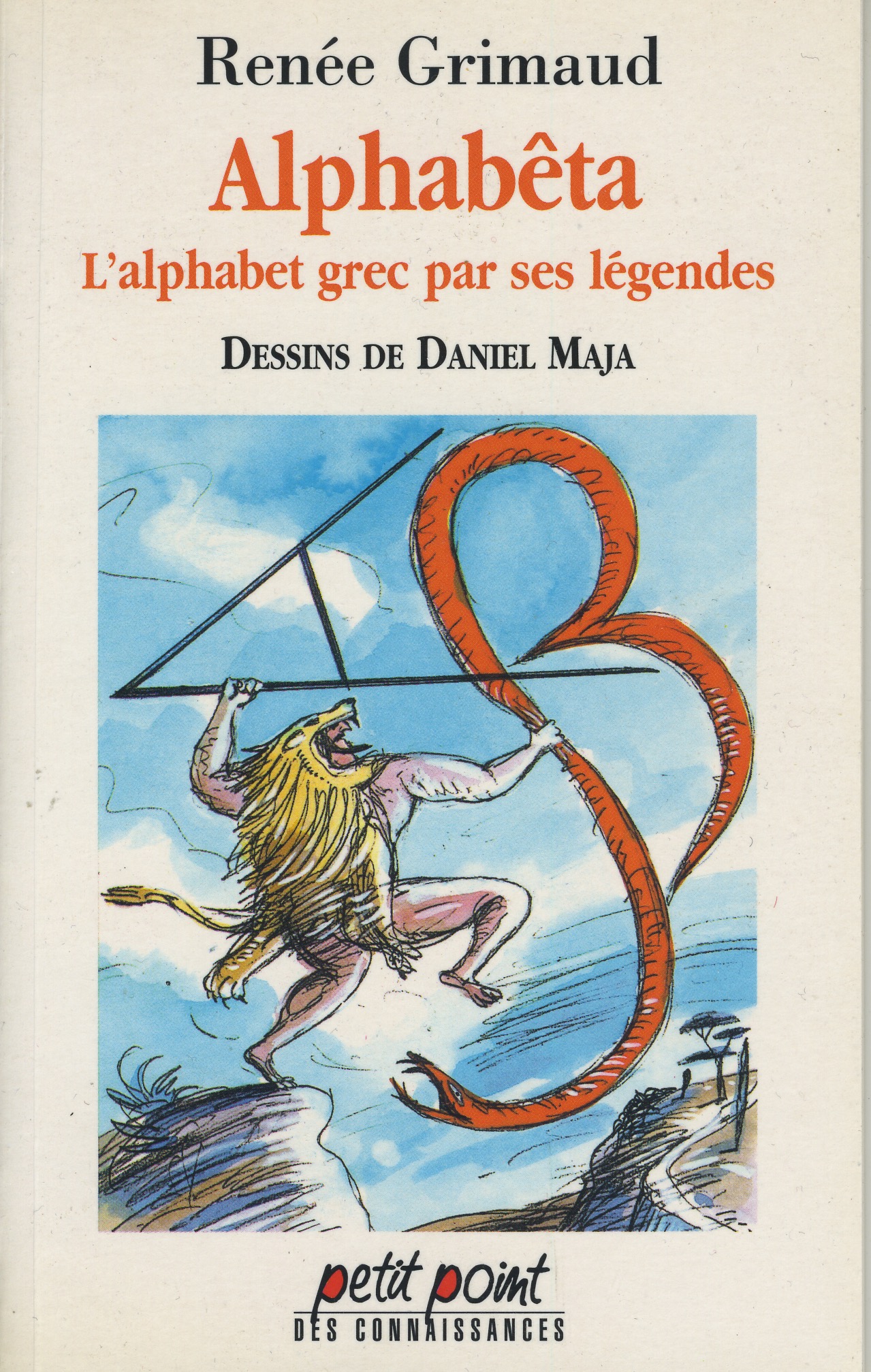
Courtesy of Daniel Maja.
Author of the Entry:
Marta Pszczolińska, University of Warsaw, m.pszczolinska@al.uw.edu.pl
Peer-reviewer of the Entry:
Katarzyna Marciniak, University of Warsaw, kamar@al.uw.edu.pl
Elżbieta Olechowska, University of Warsaw, elzbieta.olechowska@gmail.com

Renée Grimaud (Grimaud Ayanoglou)
, 1929 - 2020
(Author)
Renée Grimaud was a French historian, professor at the IREST (Institut de recherche et d'études supérieures du tourisme), passionately interested in history, art history, classical literature and archaeology. She authored many tourist guides (Paris, Havre, Normandy, Dordogne and Southwest France, Italy, Venice, Naples, Greece, Greek Islands, Athens, Spain) and cultural guides (Sisley, Pissarro, Renoir, Ingres, Delacroix, Degas, Corot, Manet), historical and archaeological books, published by Editions Larousse Hachette, Le Chêne, Parigramme, Hatier. Her tourist guides were translated into English, Italian, Dutch and German.
Her publications cover many periods from French history, including Gaul and Roman Gaul (Nos ancêtres les Gaulois, La civilisation gauloise), the history of Paris, the Napoleonic era or so-called “small history” (Petites histoires des grands châteaux, Le chat de Louis XV et autres animaux choyés de l’Histoire, La Roseraie de Joséphine et autres jardins merveilleux de l’Histoire, La fabuleuse histoire des nuits parisiennes). She also wrote books aimed at children which popularize Greek mythology and language: Les Colonnes d’Hercule. Atlas de la mythologie grecque and Alphabêta. L'alphabet grec par ses legends, illustrated by Daniel Maja.
Source:
Renée Grimaud biography at Babelio website (accessed: October 15, 2021).
Renée Grimaud s’en est allée at Midi Libre website (accessed: October 15, 2021).
Bio prepared by Marta Pszczolińska, University of Warsaw, m.pszczolinska@al.uw.edu.pl

Courtesy of Daniel Maja.
Daniel Maja
, b. 1942
(Illustrator)
Daniel Maja (born 1942 in Paris) graduated from l’École Estienne in Paris (former l’École supérieure des arts et industries graphiques ESAIG), a press illustrator, a cartoonist, an illustrator of many books for children and for adults, and teacher of drawing at École Émile-Cohl. He collaborated with many newspapers and magazines, both French (Le Monde, Le Figaro, Le Magazine Littéraire, Lire, Votre Beauté, Beaux-Arts, Télérama, J’aime Lire and others) and foreign (The New-Yorker). He illustrated well known books by such authors as Erich Kästner, Astrid Lindgren or Jean de La Fontaine, often published in editorial series aimed at young readers, like Le livre de poche jeunesse by Hachette, Arc en poche by Nathan or Folio Junior by Gallimard Jeunesse. Since 2008 he posts a daily drawing « la vie brève » on his website danielmaja.com
Source:
Official website biographie (accessed: October 15, 2021),
Wikipedia.fr (accessed: October 15, 2021).
Bio prepared by Marta Pszczolińska, University of Warsaw, m.pszczolinska@al.uw.edu.pl
Summary
In the beginning, the 24 letters of the Greek alphabet are introduced with their French names and pronunciation.
Selected mythological stories are presented in the alphabetical order of their titles. Each two-page layout contains a short tale and a full-page illustration in a blue colour scheme and introduces another character by their name, which begins with a particular Greek letter. The characters described are:
- Alpha – Argos,
- Beta – Bellerophon,
- Gamma – Gorgons,
- Delta – Danaids,
- Epsilon – Hermes,
- Zeta – Zeus,
- Eta – Heracles,
- Theta – Theseus,
- Iota – Jason,
- Kappa – Clytie (Oceanid),
- Lambda – Leda,
- Mu – Marsyas,
- Nu – Narcissus,
- Xi – Xanthos (Scamander),
- Omicron – Odysseus,
- Pi – Pan,
- Rho – Rhodopis,
- Sigma – Selene,
- Tau – Tantalus,
- Upsilon – Hyacinth,
- Phi – Phineus,
- Chi – Cheiron,
- Psi – Psyche,
- Omega – Orion.
The book ends with useful information about French vocabulary derived from Greek, crosswords and a quiz with a key.
Analysis
The book has both an educational and entertaining character. The author makes the Greek alphabet a key to present selected Greek myths. Because of its form of short texts, each story omits some details and/or subplots, although it still maintains the basic elements of the plot/character/episode. For instance, “η” refers to only one of Heracles’ labours – defeating the Nemean lion,
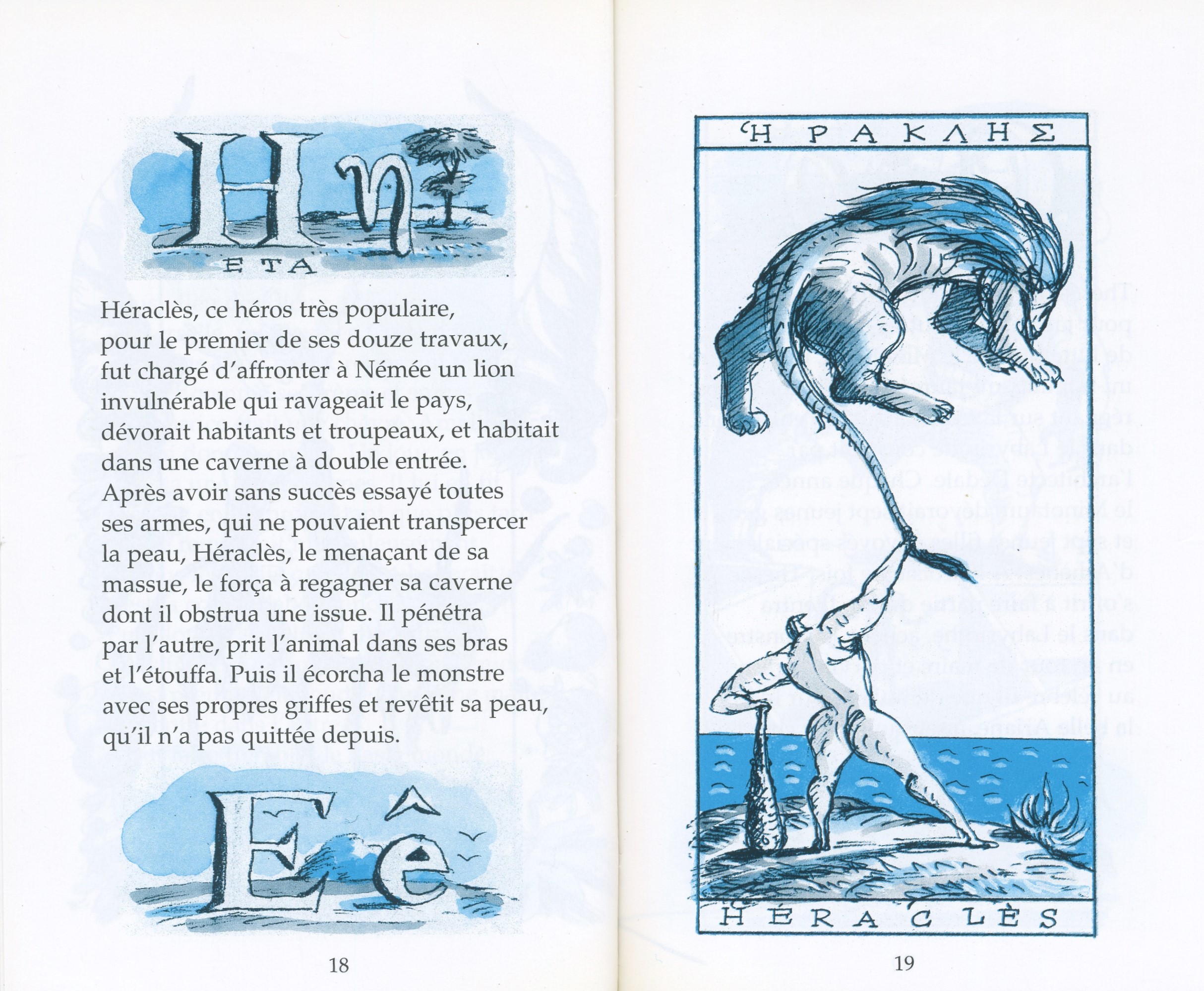
“β” presents Bellerophon’s myth with its three elements: his task of slaying the Chimaera, flying on Pegasus’ back and his will to reach Olympus. This way, the child reader is unaware of the long chain of actions leading to that particular moment or any later events.
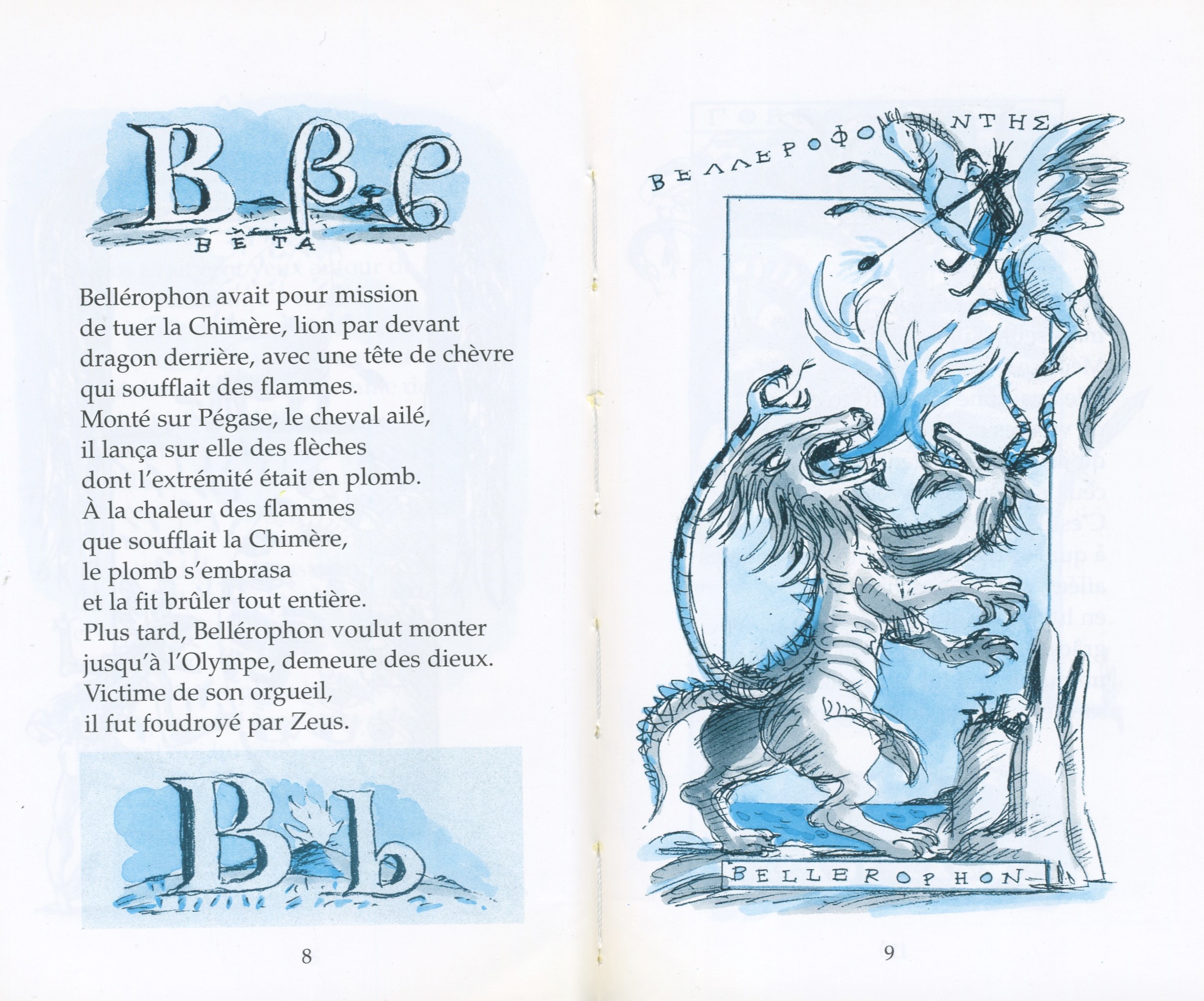
Similarly, Scamander is presented as being connected with only one situation – when Achilles killed young Trojans, and their corpses bothered the river god. “Π” for Pan explains where the French expression peur panique (panic) came from. While all entries are short (about 13–17 verses), they are at the same time easy to remember or even learn by heart. Despite the book being aimed at children, some drastic details are preserved but not highlighted. For instance, Marsyas’ punishment by Apollo, who flayed him alive and hung his hide on a pine tree*, is mentioned without any emphasis.
Full-page drawings illustrate scenes described in the text on the opposite page. They draw children’s attention and make the little story a deliberate whole. Daniel Maja used the elements of the myth combining them in one illustration. In “γ” for Gorgons, Medusa has her typical snake hair, sharp claws, and characteristic protruding teeth known from her archaic representations, while Perseus wears winged sandals and holds his huge shield so brightly polished that it resembles the mirror Archimedes used to burn the Roman fleet (according to the legend). Of course, instead of Hades’ cap of darkness, the hero wears a helmet to remain visible to the reader. In “ι” for Jason, a bull-team is driven towards the viewer, fire bursting from their nostrils, dragon teeth, and warriors also appear in the frame.
The layout is well thought out and facilitates assimilation of the information provided; even small details matter and have a special meaning. For example, each of the short poems starts with a name of a Greek letter and its drawing in uppercase and lowercase (β is presented with two lowercase variants) above the text and ends with French equivalents at the bottom. Similarly, the Greek name is placed above the drawing in all the illustrations, the French one below. In the framing of some pictures, a few relevant elements are drawn, like the motif of the cornucopia connected with the story of baby Zeus and his nurse, the goat Amalthea (see Addenda), or heliotropes in the framing of Clytie’s story. Even such small details, like Theseus’ oval shield with the horizontal line resembling the uppercase “θ”, are present.
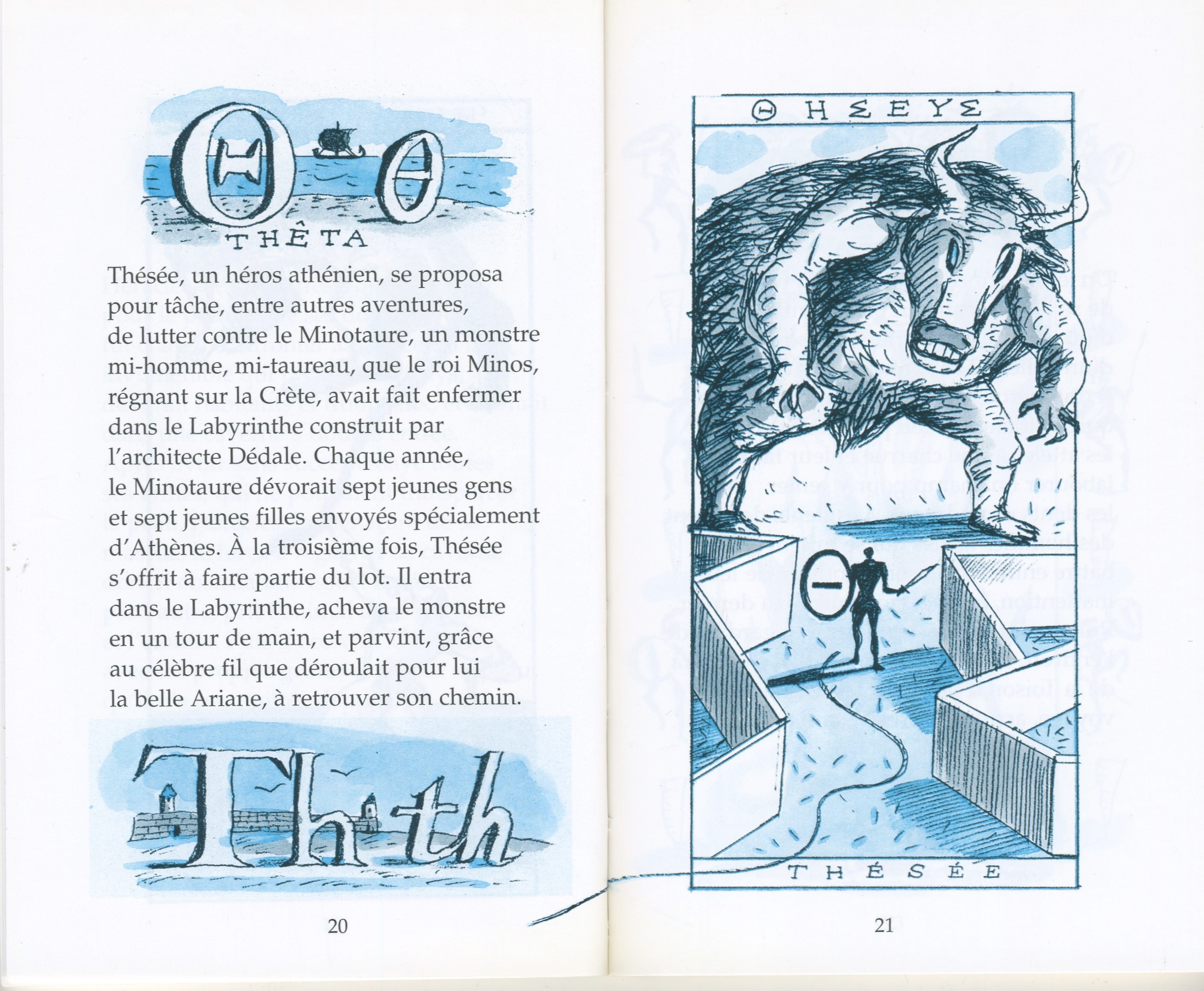
The book provides other playful, educational materials – a crossword checking one’s knowledge about Heracles’ life and Odysseus’ journey – and fun facts, mainly French words borrowed from Greek. In conclusion, the book can be regarded as a source of valuable information about the Greek alphabet, letters and mythological characters of interest to small children. Of course, it does not cover all the topics of Greek mythology but can be used as a fun first companion familiarizing the child with mythical gods and heroes, as well as encourage the child to find out more.
* "Marsyas, piteux,
Dut s’avouer vaincu
Et connut une triste fin.
A un pin suspendu,
Encorché vif, il mourut." (p. 28)
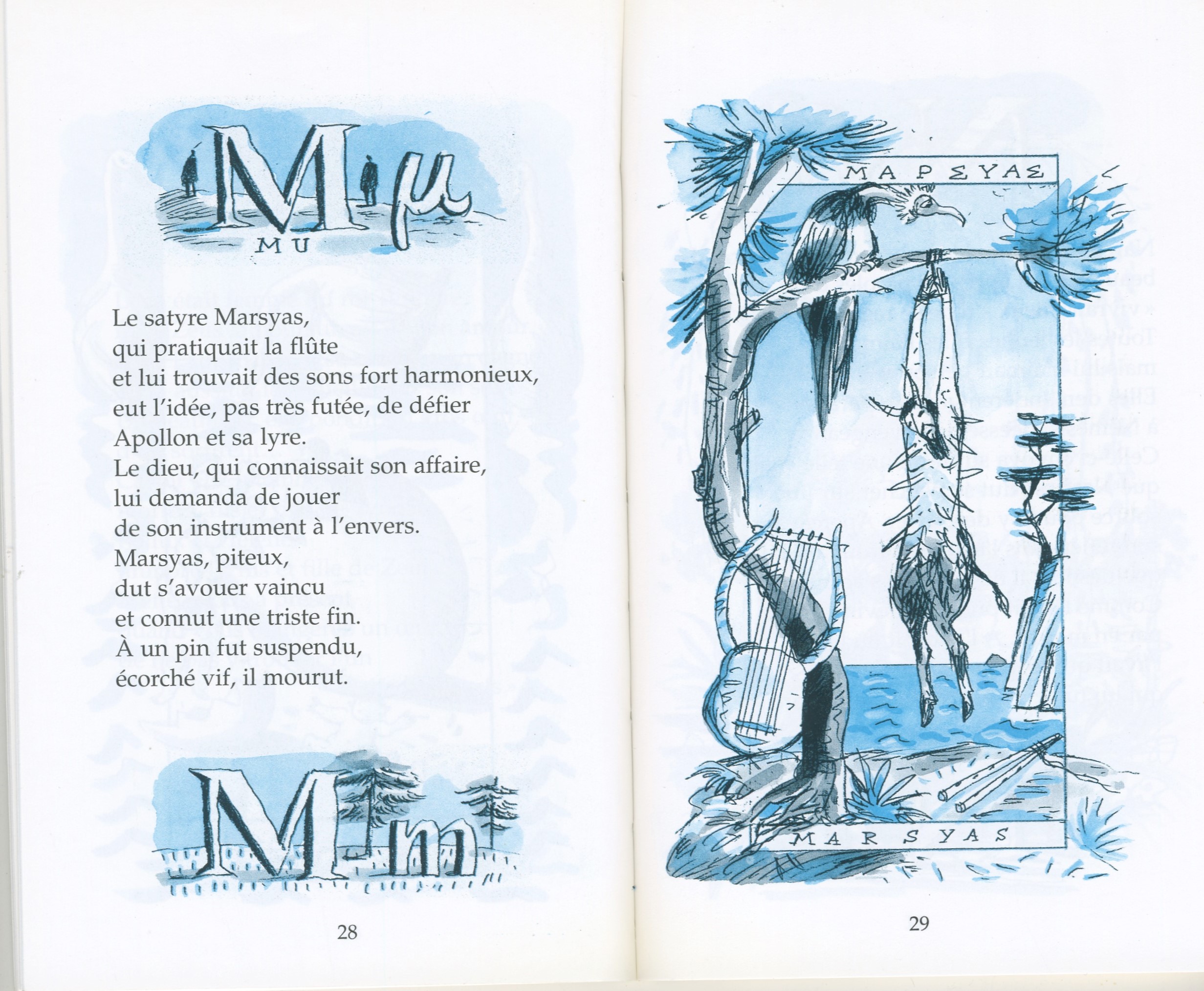
Illustrations courtesy of Daniel Maja.
Further Reading
Chaney, Jeanne H., “Alphabet Books: Resources for Learning”, The Reading Teacher 47.2 (1993): 96–104 (accessed: September 25, 2021).
Evans, Mary Ann, Jean Saint-Aubin, and Nadine Landry, “Letter Names and Alphabet Book Reading by Senior Kindergarteners: An Eye Movement Study”, Child Development 80.6 (2009): 1824–1841 (accessed: September 25, 2021).
Grimaud, Renée, Les Colonnes d’Hercule. Atlas de la mythologie grecque, Paris: Hatier, 1992.
Grimaud, Renée, Sous nos pas, Gaule, Paris: Hatier 1993.
Le Men, Ségolène, Les abécédaires français illustrés du XIXe siècle, Paris: Editions Promodis, 1984.
Takala, Annika and Kerttu Vepsäläinen, “Elements of World View Conveyed by ABC-Books and First Readers in Different Countries”, Internationale Schulbuchforschung 7.2/3 (1985): 137–150 (accessed: September 25, 2021).
Addenda
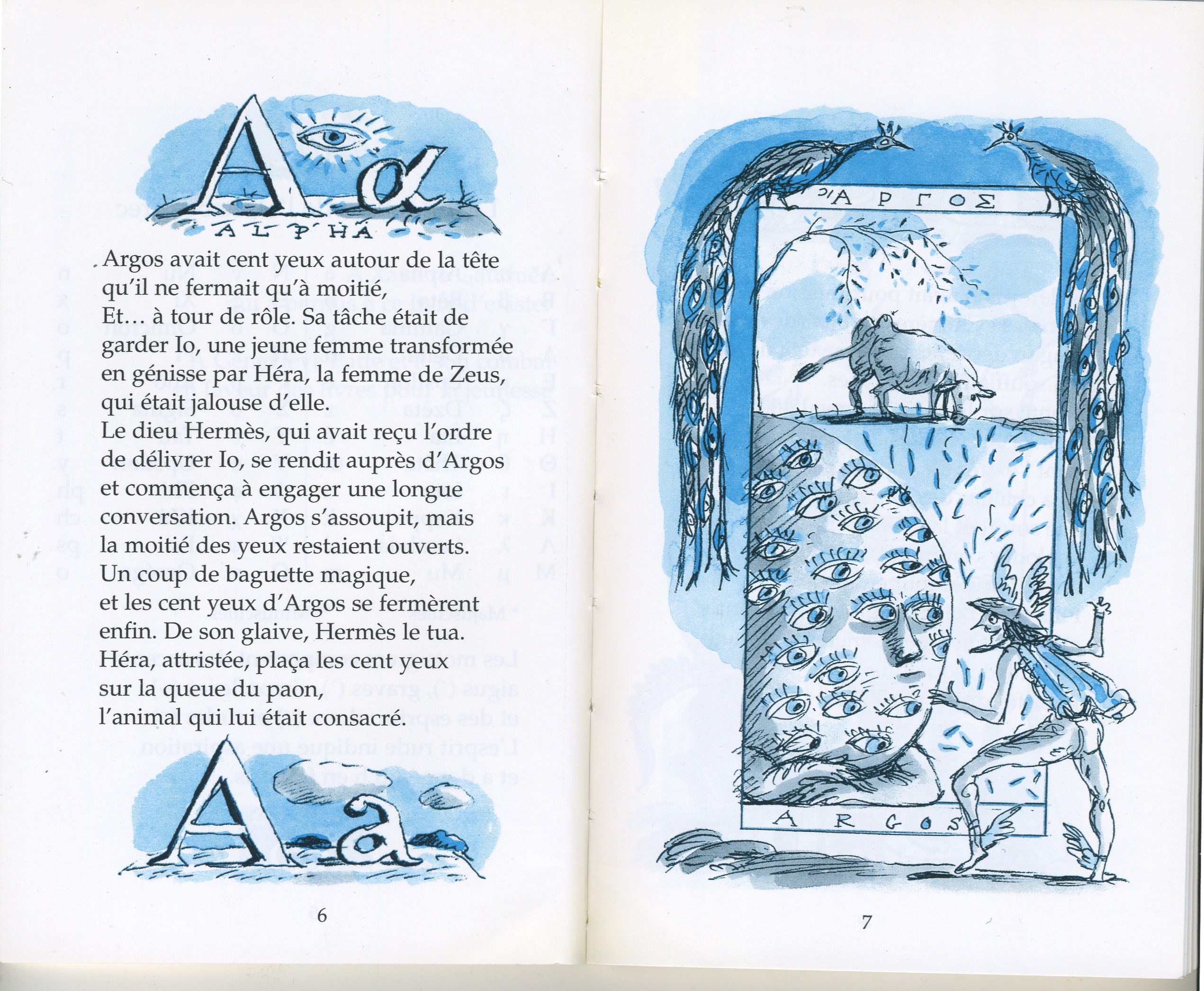
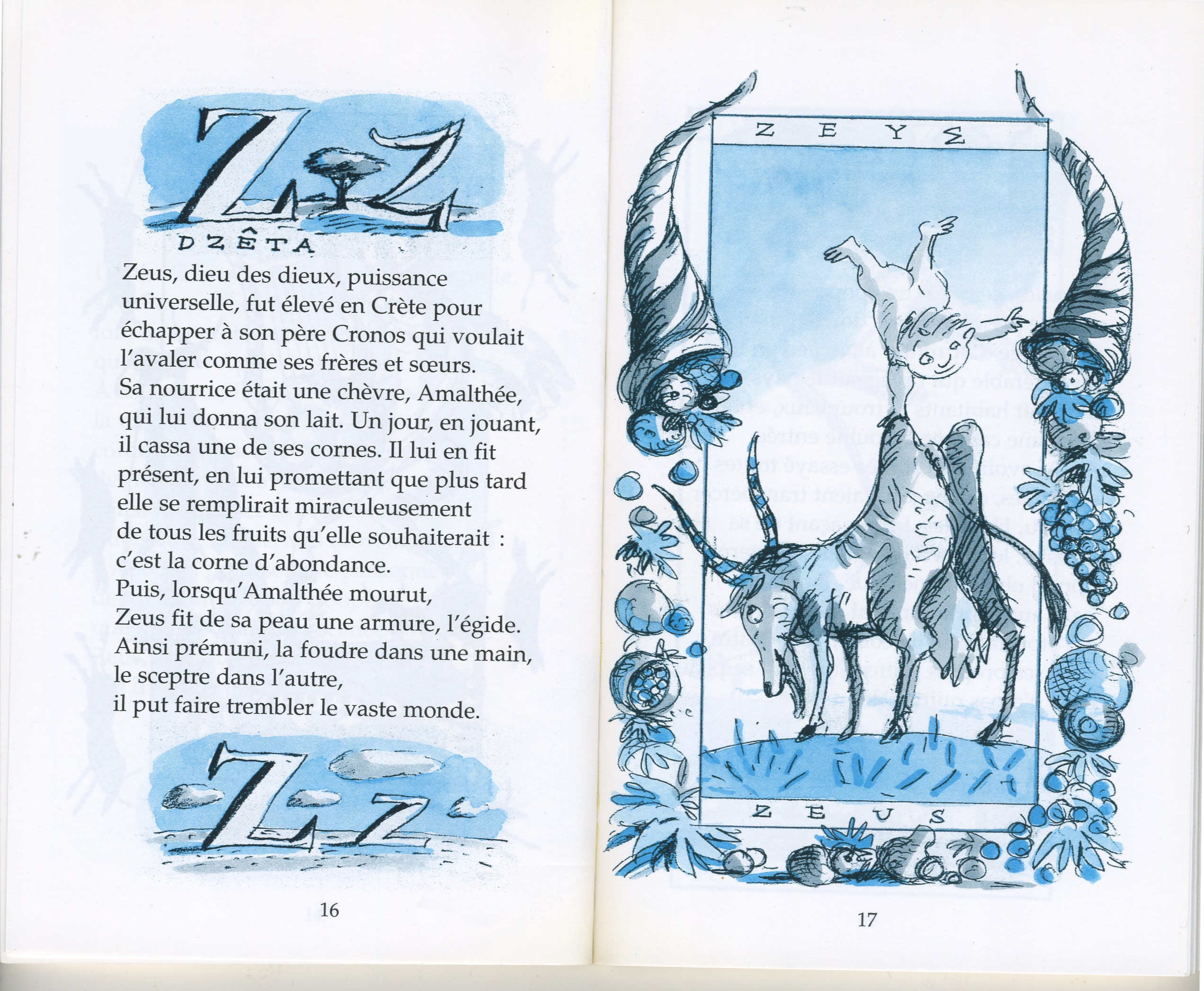
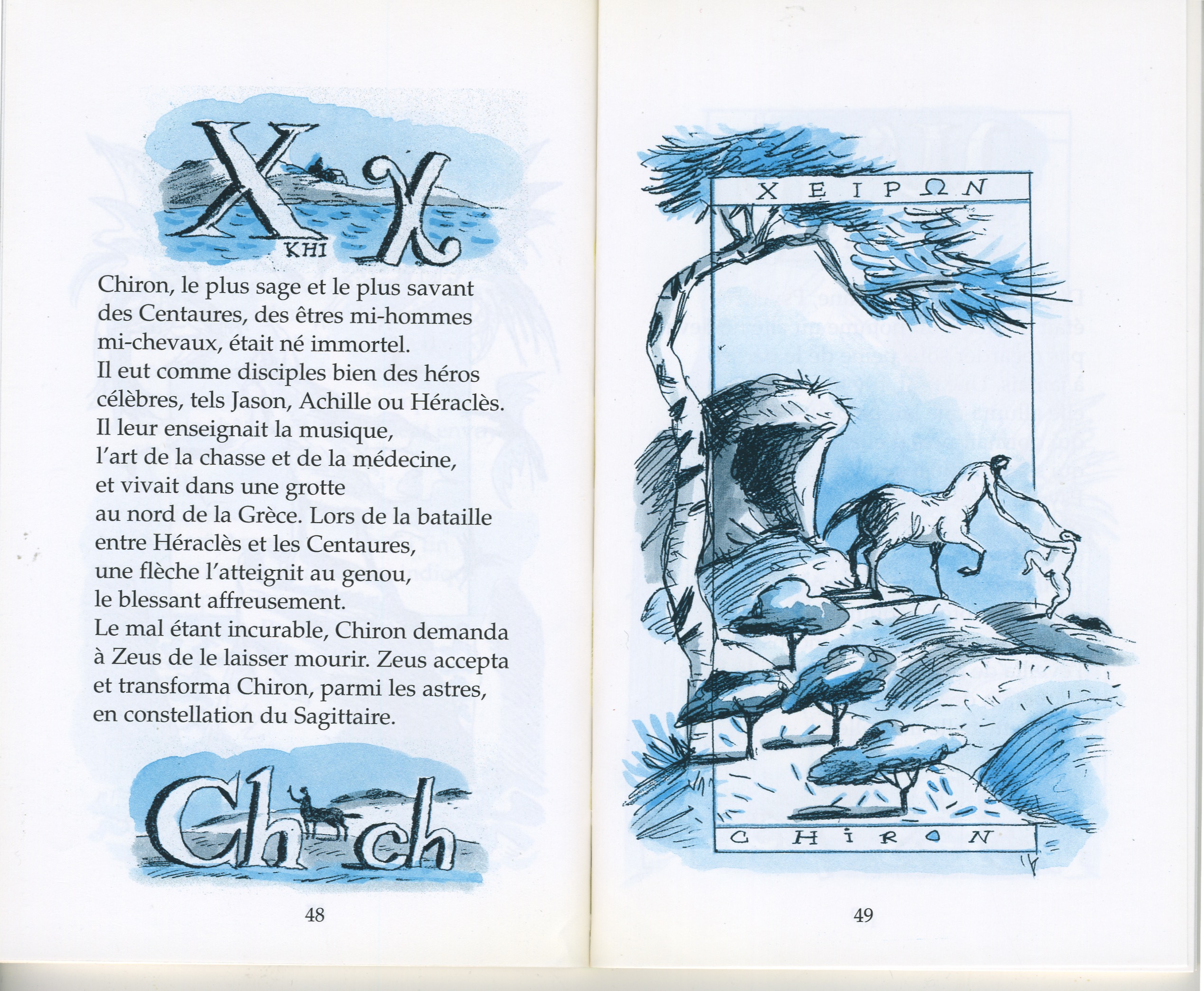
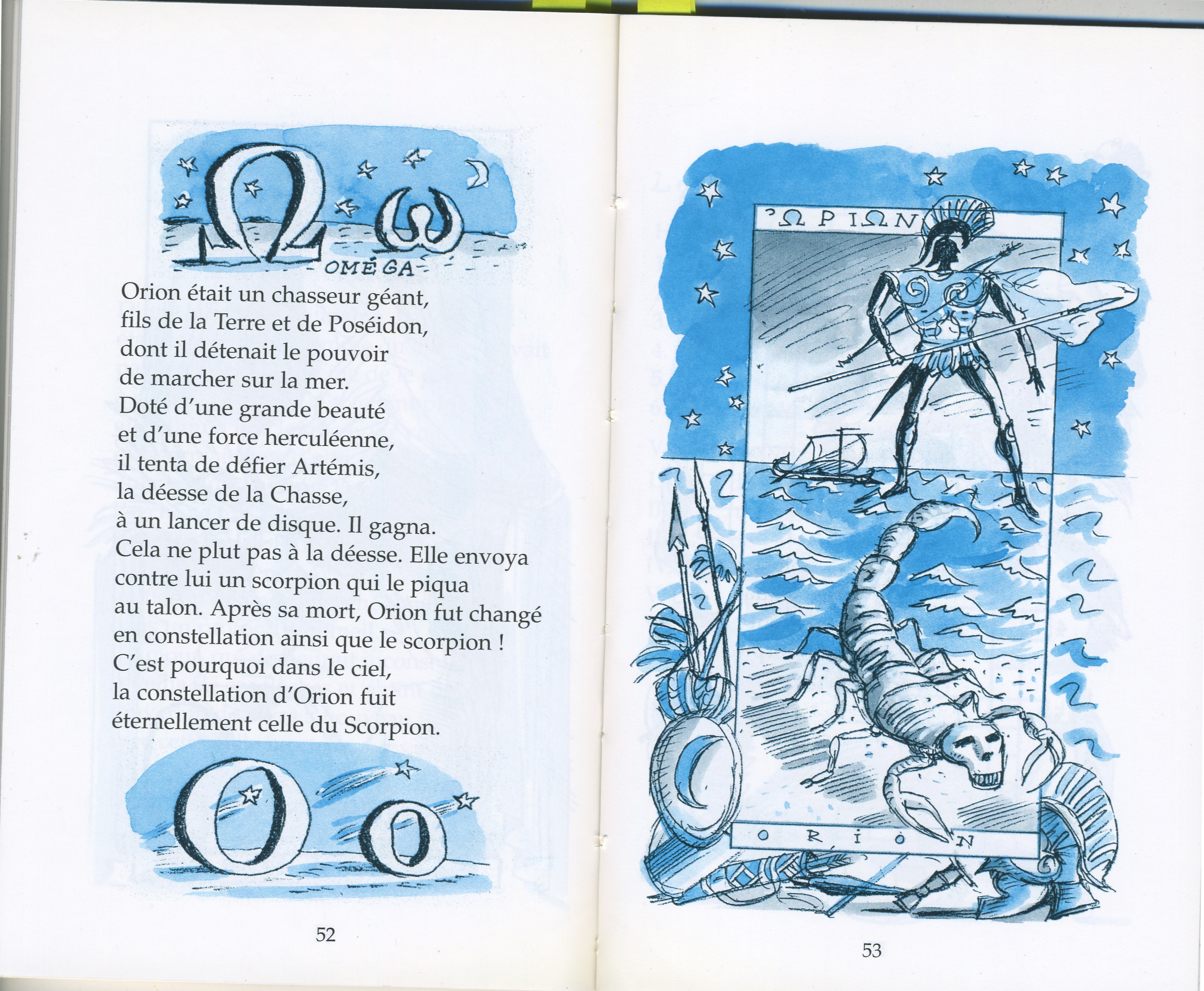
Courtesy of Daniel Maja.


